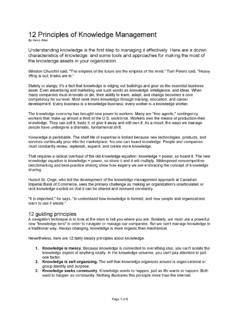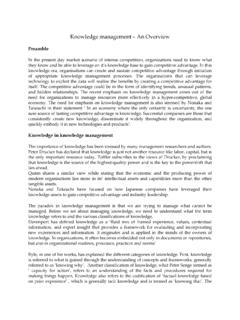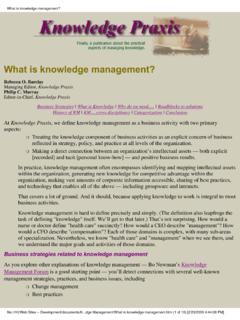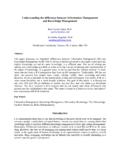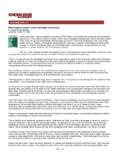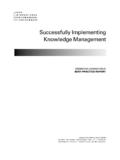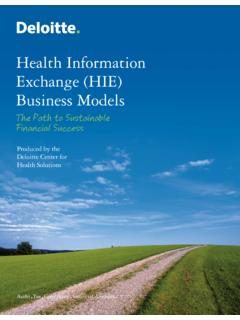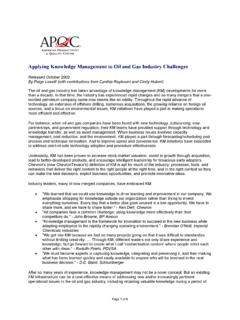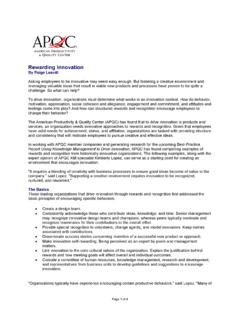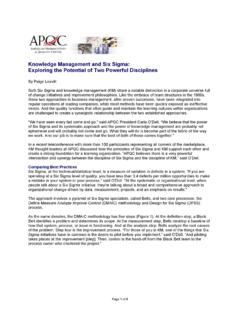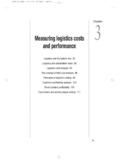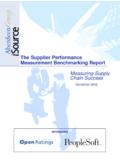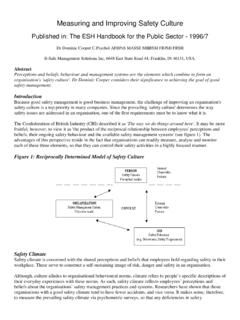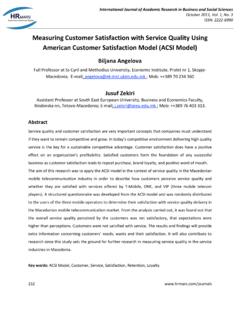Transcription of Measuring Knowledge Management - Provider's …
1 Measuring Knowledge Management Released August 2002 By Wesley Vestal The American Productivity & Quality Center (APQC) conducted its first examination of Knowledge Management (KM) at a Knowledge Imperative Symposium in 1995, at which time organizations were simply trying to come to grips with the power of sharing and reusing Knowledge for business purposes. While KM has become a widely accepted business practice in the interim, companies still struggle to measure the gains it purports to offer. As APQC begins its 10th best-practice consortium study in KM (Using KM to Drive Innovation), Measuring the success of Knowledge Management efforts still vexes many organizations.
2 An 11th KM study by APQC, which will kick off in the fourth quarter of 2002, will focus on this critical component of KM. We d like to examine this topic and offer a preview of what the KM measurement study might uncover. First, we will talk about the importance of measures. Second, we ll discuss why determining the return on investment (ROI) of KM efforts is so important to the long-term viability of a KM initiative. Third, we ll talk about one method to develop effective KM leading and lagging measures to help ensure that employees are sharing and reusing Knowledge to improve business processes.
3 Finally, we will outline how effective measures can foster the people and process changes necessary when embarking on a KM initiative. The Importance of Measures In these budget-constrained, uncertain economic times, KM practitioners need to be able to show the business value that Knowledge sharing and reuse bring to their organizations. Most businesses use measures to derive metrics that show performance or effort. Measures outline the information or data a company or person wants to gather (for example, customer satisfaction, productivity of workers, or cost savings).
4 As APQC defines them, metrics are normalized quantitative measures usually used to gauge operational performance or resource allocation such as cost per square foot, invoices per full-time employee (FTE), or production run time. When an organization builds effective measures and tracks metrics around Knowledge sharing, then tracking the success of implementation, identifying key milestones, and showing return on investment become possible. There are two things that all organizations should keep in mind as they develop measures and metrics. First, it is extremely difficult to create any measure of Knowledge sharing that will show an absolute one-to-one correlation between a Knowledge -sharing action and a business result.
5 Much like Measuring the success of training and development programs, Measuring the impact of Knowledge sharing requires correlation and some assumption. Second, to truly understand the impact of Knowledge sharing and reuse, an organization must first understand the baseline business or process performance before beginning KM efforts. If you do not know where the starting line is, how can you say what your time is at the finish line? ROI is critical One of APQC s adages has long been that organizations should not expect to see a significant ROI from KM too quickly.
6 ROI takes time to gather due to the complexity of understanding the impact that people, Page 1 of 6 process, content, and technology have on Knowledge sharing, and subsequently, the business. Many senior executives embark on the KM journey by taking a leap of faith because they understand that sharing and reusing Knowledge just makes good business sense. However, the price tag of aligning people with tools, content, and processes that facilitate Knowledge flow is not small. In the late 1990s, when IT money seemed to flow ceaselessly, many organizations had the leeway to work through many of the growing pains of establishing KM without the strict cost pressures we see today.
7 Now, Management needs to understand the value of each investment and weigh it against the potential gains from other change efforts. Showing ROI for KM is critical. Many KM programs use both success stories and measures to develop this ROI case. APQCs best-practice research indicates that most organizations spend hundreds of thousands, and in some cases millions of dollars buying and implementing technology tools, publishing and validating content, developing people and expert resources, and redesigning work processes to support more efficient Knowledge sharing.
8 In a recent Ziff-Davis article on KM, Prudential Insurance highlighted its efforts to build a KM system to support its sales force. "The software cost less than $500,000. Creating new content and organizing existing information ran another $500,000. In the financial world, where regulations and products change continually, keeping the information up to date-with high-priced lawyers reviewing material for compliance-turned out to be an expense itself: roughly $300,000 per year." Many organizations have turned to storytelling and anecdotal success stories to show the value of the investments made in KM.
9 Stephen Denning of the World Bank has written a book on the power of storytelling, and companies like Xerox, Chevron, and Schlumberger all have worked to create a virtual coffee bar where success stories are told. However, while stories help to personalize the effects of Knowledge sharing, many managers want proof. That's where effective measures and metrics come in. Sir John Brown, CEO of BP, uses the following example when explaining BP's KM initiative: "Every time we do something again, we should do it better than the last time. Deep-water drilling is a good example.
10 In 1995, we spent 100 days drilling a deep-water well. We now spend 42." This is a good example of developing a story out of metrics. BP knew how long it took to drill a deepwater well before it began systematic Knowledge sharing and measured the time after implementation. The result is a story that people can relate to and numbers that people can believe. So now that we've said that measures and stories are good ways to show Management the return on investment of KM, what ROI should you expect? Each organization is different, but based on information from a handful of best-practice organizations, ROI for KM investments ranges anywhere from :1 all the way up to over 10:1.
